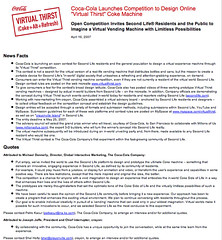Why PR Doesn't Work and How to Fix It

Click here to read this article using ThinkFree Docs
There have been a series of interesting posts, comments, and opinions regarding why PR doesn't work and why so many CEOs have a bad taste in their mouth at the mere mention of public relations.
Industry veteran, financier, and marketing evangelist Guy Kawasaki sparked the latest thread with his post, "The Top 10 Reasons Why PR Doesn't Work." Kawasaki then followed up with DIY PR, a guide to "do it yourself" PR penned by Glenn Kelman, CEO of Redfin.
With titles like that, you better believe it's going to ruffle some feathers and bruise egos with every new comment, link and blog post.
Truthfully, there are 1,000 reasons why PR doesn't work and there are also countless reasons why it does. There are also times where DIY works, to an extent, which eventually evolves to require an internal team or an agency - depending on the goals and reach of the campaign.
According to Guy's first post, who in turn is sourcing Zable Fisher of ThePRSite, here are the top 10 reasons why PR doesn't work:
1 - The client doesn’t understand the publicity process
2 - The scope of work is not detailed and agreed upon by both parties.
3 - The client has not been properly trained on how to communicate with the media
4 - The scope of work is not detailed and agreed upon by both parties.
5 - The client and the PR person or firm are not a good match.
6 - The client has not gotten results quickly enough and ends the relationship too soon.
7- PR people don’t explain the kind of publicity placements a client will most likely receive.
8 - Clients don’t realize that what happens after you get the publicity coverage is sometimes more important than the actual placement.
9 - Clients refuse to be flexible on their story angles.
Clients get upset when the media coverage is not 100% accurate or not the kind of coverage that they wanted.
10 - Clients won’t change their schedules for the media.
Well then, let's just hang up our hat trying to refine our client services or management brown-nosing, as we've finally figured out how to strip PR down to such a basic sense of parity, that if we could get these top 10 questions answered or figured out, that we could solve the industry-wide plague of bad PR.
This really seems to make sense to those that subscribe to the belief that there's no such thing as bad PR. Nevertheless, PR is not a commodity - but bad PR is available anytime, anywhere.
Good friend, Dave McClure, seemed to capture it more accurately - at least for those of us in a world that demands we prove value and worth using metrics outside of whether or not we get along with people, trained our spokespersons well, or explained the publicity process so that executives could have something other than running a business to worry about.
1 - The PR firm doesn't understand the product or technology.
2 - The PR firm is seen as a spinner, blocker, or gatekeeper to access the CEO/CTO/braintrust.
3 - The PR firm hasn't been properly trained on how to communicate with bloggers or social media. 4 - The PR firm prefers doing a few big traditional media over lots of smaller online media & online channels.
5 - The PR firm doesn't understand SEO, SEM, widgets, blogs, tags, social networks, pictures, video, or other online & viral methods, aka "all that Web 2.0 stuff".
6 - Most PR folks have no clue what the hell TechMeme is.
Ask anyone what's wrong with PR and you'll unintentionally draft the manifesto of varying top 10 lists that will form as the foundation for revolution in the communications business. Call Guinness while you're at it. I'm sure we'll break some records.
Rather than highlight what's wrong with PR or why it doesn't work, let's talk about how to fix it. (If you're in tech...please read this article first as it serves as the primer for PR in the face of new media. Web 2.0 marketing has generated many new lessons, strategies, and tools that benefit almost every industry.)
No matter what business you're in, there are a few things that can help you succeed in, manage, or measure PR. This list is a game changer and can serve as the foundation for improving PR and elevating its value among those who have been burned by previous experiences.
PR for PR People
1- Realize this as your number one priority...just because you show up to work and do your thing doesn't mean you kick ass in anything other than maybe, just maybe, deserving to keep your job.
2 - If you expect to represent anything, whether in an agency or in a company, spend a significant portion of your time figuring out why it matters to people - on your own time. This is the difference between PR and good PR.
3 - Figure out who your customers are and where they go for their information. This forces PR to mirror sales strategies in order to reach the people that could benefit from said product/service. Different people go to different places for information. First determine where you want to be and then work backwards from there.
4- Read the blogs, magazines, newspapers, forums, newsletters, etc., that reach them and understand how to translate what you do in a way that matters to them. This is the only way to be successful in running PR in the long tail. People within your target markets share experiences, pains, and wants that are unique to each group. By reading, you're participating. And by participating, you're better staged to engage more effectively than the rest of the flacks.
5 - Read # 4 again.
6 - Don't speak in messages, spark conversations based on the unique requirements of each market segment and the people within them. And please, don't spin. We all hate when politicians do it. If you find yourself consistently selling or spinning rather than evangelizing you might be in the wrong place in your career.
7 - Traditional PR still matters, but also embrace social media (after you've had a chance to participate as a person, and not as a marketer). This is the future of PR, understanding how it works and what it takes to participate will ensure that you're experience is relevant to the communications needs of businesses over the next decade.
8 - Attacking the "audience" with PR campaigns no longer works in new media. You have to engage with people through the diverse segments that represent your target market.
9 - When working with reporters, bloggers, analysts, and other influencers, spend a significant amount of time understanding what they write about, to whom, and why. Then take your story and align it accordingly. One story no longer applies to the masses.
10 - Once you understand what it takes to make the story more compelling to the varying markets and the influencers that reach them, then and only then, think about press releases. One press release doesn't carry across the entire spectrum of customers any longer. Figure out the core value proposition and then write several different flavors based on the needs and pains of your target customers and how you help them do something better, easier, more cost effectively, that they couldn't do today.
11 - Set goals with the executive team of the company you represent. Based on the previous points, you have to ensure that your activities align with their business strategy. Ask them to define success month-to-month, so that you can all agree, in advance, what it takes to move forward. Create the PR program that will help you acheive those goals. If there is anything outside of your control that stands in your way of success, then do what it takes to fix it. If your spokesperson is horrible, then either train them or tell them that you need someone else. If the product/service isn't wowing people, find out why and what it takes to compell people to use it.
12 - Communicate progress regularly, document milestones, and showcase successes. PR often suffers from a lack of "PR for the PR." If you don't demonstrate success, who will. By communicating progress, status, and feedback, then you can consistently prove your value to those that underwrite the PR program.
Company Executives
1 - Understand first, what PR is and isn't. All too often, businesses expect PR to perform miracles simply because they confuse it with advertising, online marketing, media buying, search marketing, etc. PR can't guarantee legitimate coverage in industry publications - no matter how tight the relationship. If PR promises it, then they're lying. I leverage relationships daily to consider stories that I package in a way that's most relevant to them. Most of the time it works because I take the time to make it valuable to respective markets. If I took advantage of my contacts to force coverage whenever I needed to deliver on a promise, then it would mark the beginning of the end of my relationships.
While I won't compare PR to each branch of marketing, I will say that PR IS NOT ADVERTISING. Reporters and bloggers don't stop what they're doing to write about your company, just because we send them a press release. They're bombarded by PR people all over the world. Stories are cultivated. If we respect them, do our homework, and help highlight the value of a story, coverage is imminent. If you want guaranteed exposure, buy an ad.
2 - Don't under value PR. PR, when done right, is extremely valuable to company branding, which has immeasurable benefits in the long haul. Customers have choices and if you're not consistently vying for their attention, it's pretty easy to fall off their radar screen when they evaluate options. Too many companies nickle and dime PR to the point of absurdity. Don't get me wrong. Expensive PR doesn't equal success. But short changing PR is usually a first step in the wrong direction.
3 - PR is not a switch. It doesn't go off and on whenever you have the time or budget to throw at it. The market moves too quickly, and if you're not actively participating in it, you'll quickly find that company sales and site traffic will begin a downward spiral that may or may not recover.
4 - In most cases, coverage doesn't just happen. PR is like farming. The more seeds you plant, along with the time you spend watering, caring for, and feeding them, your crops will grow in the form of coverage over time. While some things such as news, etc., force information out quickly, other stories take time. And when they appear, they help raise brand visibility, drive some people to buy, and they also spark others to consider writing about it - which in turn also influences the cycle to replicate. Don't assume all of this coverage happens simply because you are a popular company.
5 - Just because you created the product doesn't mean you're the best person to sell it. I've worked with some of the most passionate executives that just don't click with the people they're trying to engage - no matter how hard they try. Suck it up and get a spokesperson who can help tell the story to the people that will help grow your business.
6 - Understand that PR is only an umbrella for the specific communications initiatives that will help you reach complementary, simultaneous goals. For example, corporate branding and product marketing require different campaigns.
7 - No matter what industry you're in, realize that the most popular blogs, newspapers, or magazines are only one part of the process. Your market is divided by adoption and buying behavior and documented through a bell curve rich with chasms, pyramids that further divide and classify them, quadrants that demonstrate competitive advantages, ladders that represent the technology that people can use to reach customers in different ways, a cluetrain that shows how people carry it through the long tail, and hopefully reflected by a hockey stick that forces you to evaluate what to do from Inside the Tornado. Yes, of course this was meant to be funny...but it does show that one program no longer serves the masses when you deconstruct it by the markets and the people that comprise it.
This means that you have to embrace both new media and traditional media in PR. For example, in the tech space, TechCrunch, Mashable, Venture Beat, Read/Write Web, et al, will yield measurable traffic so great that most of the time it will knock out company servers. Every executive wants them. CEOs cry if they can't get coverage on them. But, by no means, do they carry your value proposition to the entire collective of people that will embrace your product and help sustain your business for the whole game.
They represent the early adopters and pragmatists. However, there are other worlds of global microcommunities rich with horizontal and vertical publications and blogs that will carry your story to the more conservative groups of people that collectively converge as the primary base of recurring revenue.
In this case, it's less about traffic and hits as metrics for success and more about quality, registrations, purchases, referrals, etc. that define business growth.
Blog about industry-relevant topics, not just company accomplishments. It's not a new tool in the marketing belt. It is a new opportunity to engage customers and cultivate relationships. Simply put, be a resource for your community.
Embrace online video and watch how creative, genuine, and cool content becomes incredibly viral. Words can carry the message so far, but video is also an opportunity to showcase the product while entertaining viewers.
Podcast new updates, customer successes, ideas for new product uses, etc.
Bookmark and share relevant links using the popular social tools available.
Cultivate user generated content.
If relevant, build transparent profiles in the social networks where your customers can find and support you.
Share images and behind the scenes footage using services such as flickr, zooomr, and YouTube.
Hire a community manager. In the new world of social media, new PR can be complemented through the efforts of someone who can actively represent the company in all things social so that they can provide proactive information and support to people looking for guidance in the communities they frequent. Don't market to them, have conversations.
Note, this is a ultra-simplified list of how to jump into the world of social media.
9 - Support your PR program and feed it as you do any other branch of the company. Respect it when it works and let your team share in the success. Don't focus on the shortcomings. Extend congratulations as goals are acheived.
10 - If you find a PR person that truly lives and breathes the company and the product, never let them go. They are a rare breed and deserve support and promotion.
11 - Meet with your PR team regularly to communicate realistic goals and measure progress. Paint a real world picture of what success looks like each month and listen to the reports to see if they are indeed attainable. You get out of PR what you put into it.
12 - Agree upon metrics in advance. All too often executives lose sight of what PR is designed to do. The right coverage is invaluable, even when it doesn't translate into visible hits, traffic spikes, or sales. Super Bowl ads, for example, rarely pay for themselves in the short run.
Realize that a proactive, intelligent and consistent PR program will contribute to the bottomline. It shouldn't be solely responsible for company success or failure.
Metrics can be in the form of specific targets every month, registrations, lead generation, links, and now, conversations.
Additional stories:
Jeremiah Owyang update - thanks Jeremiah for the kind words!
Andy Lark's incredible response - Yes PR works!
Chip Griffen - Should a company try DIY or a PR team? (the answer is in my post)
JournaMarketing - The real reasons why PR doesn't work
Matthew Stibbe on Why PR doesn't work and also on DIY
Hugh McLeod also on Why PR doesn't work
Gary Reid
Publicity for small business growth
Mike Manuel
Global Nerdy
Jeremiah Owyang
Dave Donohue
pr pr2.0 media2.0 publicrelations public+relations media+2.0 media 2.0 public relations socialmedia social+media social techcrunch brian+solis web2.0 web+2.0 cluetrain conversation marketing marketing2.0 advertising online marketing+2.0 guy+kawasaki geoffrey+moore long+tail longtail forrestor technographics






































